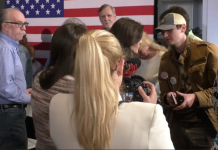In the months between the election of Donald Trump and January 21st, 2017, women gathered together in small yarn shops to craft. Across the country thousands of bright, pink “pussy-hats” were knitted, crocheted, and sewn. Supporters of women and the Women’s March found solidarity in creating these hats. Those who couldn’t attend the march in Washington, D.C. sent hats for others to wear and a sea of pink was created.
The creation of the “pussy-hat” was a play on the words “pussy-cat” and a reaction to President Trump’s “grab ‘em by the pussy” comment brought to light during the 2016 election. The founders of The Pussyhat Project wanted to flip the narrative, claiming a derogatory word as one of empowerment for women.
This isn’t the first time fashion has been used as a political statement and it won’t be the last. After all, Trump’s rallies are marked by crowds wearing red hats emblazoned with the words “Make America Great Again.”
During the Women’s Suffrage Movement, women wore white to represent purity and virtue while also appearing feminine. Even more recently, the women of the US Congress donned suffragette white in early 2019 at the State of the Union address. Women in politics have used white to make statements for years, most often during moments of progress or protest.
Geraldine Ferraro, the first female vice-presidential candidate, wore white during her acceptance speech. Hilary Clinton donned a white pantsuit while accepting her presidential candidacy. Alexandria Occasio-Cortez, the youngest woman to be elected into Congress, wore white to her swearing in ceremony. Occasio-Cortez referenced her attire in a tweet that same day.
“I wore all-white today to honor the women who paved the path before me, and for all the women yet to come. From suffragettes to Shirley Chisholm, I wouldn’t be here if it wasn’t for the mothers of the movement.”
The impact of fashion carries on through the ages and continues to be a notable aspect of starting or continuing a movement. Designers have caught on to this; in 2017, a white cotton t-shirt that read We Should All Be Feminists by Dior was named “Dress of the Year” by The Fashion Museum.
Fashion activism is booming, from Beyonce’s Super Bowl halftime show with dancers wearing the berets of the Black Panther Party to Ireland’s Repeal sweatshirts supporting abortion rights. But while utilizing fashion to make a statement can be seen in many causes, that doesn’t always mean your opinion is broadcast across your chest.
The removal of clothing has also become a form of fashion activism. In 1968, the Feminist Movement protested the Miss America pageant by throwing bras, high heels, and girdles into a trash can. They called these items “instruments of female torture,” and spoke against the objectification of women.
PETA launched a well-known campaign against fur in the early 2000s that continues today. They enlist celebrities to pose nude on posters with the tagline “I’d rather go naked than wear fur.”
Even more recent, women in Iran have been removing their hijabs in protest of the compulsory hijab laws. Some women can face up to 10 years in prison for removing their hijab and going out in public or posting photos or videos without the head covering. Yet they continue, creating a movement to cause change.
2019 marks 100 years since the ratification of the 19th amendment, giving women the right to vote. From the white of the Suffrage Movement to the bright pink of the Women’s March, fashion unifies movements, promotes change, and inspires generations.




















